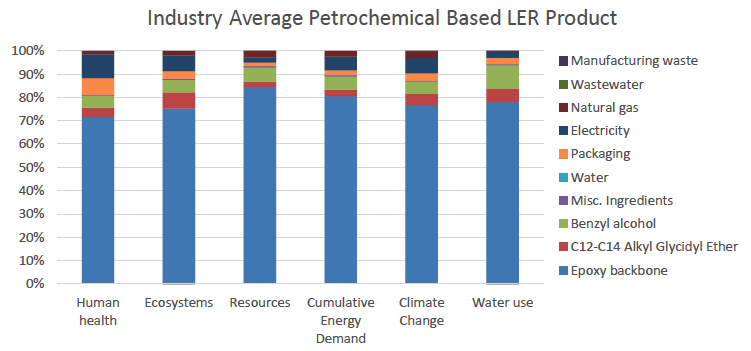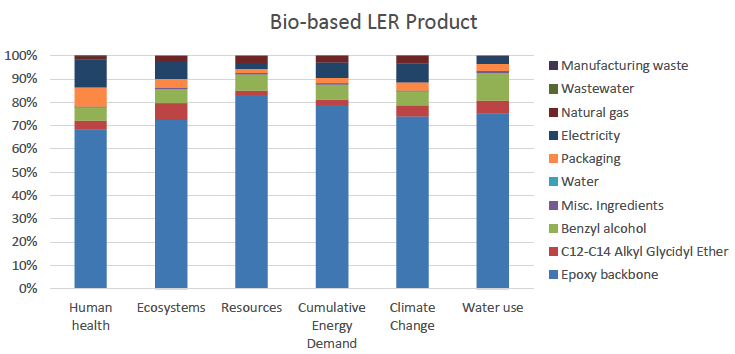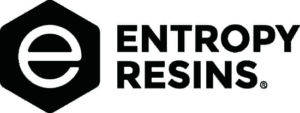A cheat sheet of acronyms.
It’s hard to talk about Life Cycle Assessment (LCA) without resorting to a lot of acronyms. Before we look at why we had this assessment done for Entropy Resins, here is a handy acronym cheat sheet to keep us on track.
- BPA—Bisphenol A: A chemical backbone of epoxy formulations
- ECH—Epichlorihydrin: Another chemical backbone of epoxy formulations
- LCA—Life Cycle Assessment: An analysis of a product’s environmental impacts
- LER—Liquid Epoxy Resin: Refers to all epoxy resins and hardeners in the study
- LTS—Long Trails Sustainability: The independent product stewardship organization that determined our LCA
The goal of our LCA
We wanted to provide a clear picture of how biobased Entropy Resins epoxy formulations impact the environment compared to the industry average for petrochemical-based epoxy formulations. The LCA calculates these impacts from “cradle to gates,” which take into consideration every step of processing the epoxy. Cradle refers to the beginning of the process when raw materials are extracted. LCA tracks the transportation of our epoxy’s raw materials, how those are refined and processed. Gates refers to the stage when the epoxy products are set to be shipped from our manufacturing facility in Bay City, Michigan.
Each unit counted by our LCA refers to 1 kg of liquid epoxy resin (LER) packaged for and ready for customer use. Next, we’ll look at who did the LCA what data they used.
Who performed this Life Cycle assessment?
Long Trail Sustainability (LTS) is the organization that performed an independent LCA of Entropy Resins epoxy products. They are third-party stewardship experts as well as the North American distributor of SimaPro LCA software, and part of the SimaPro Global Partner Network.
The information considered
Primary Data
- Transportation distances and modes of travel for raw materials
- Manufacturing inputs and outputs including energy and water use, direct air emissions, and waste products
- Packaging and production volumes over a 6-month period
Secondary Data
- Raw materials
- Manufacturing
- Energy production
- Transportation
Let’s take a look at what LTS found when it compared biobased Entropy Resins to industry-average epoxies.
LTS’s Life Cycle Assessment Findings
- Compared to the industry average for petrochemical-based LERs, biobased Entropy Resins Epoxy has 11% -16% fewer environmental impacts in all categories.
- The majority of the cradle-to-gates impacts of both the biobased and industry average petrochemical LER products come from the epoxy backbone, which is driven by bisphenol A (BPA)
- Entropy Resins biobased epoxy backbone has between 15% -20% fewer environmental impacts than the industry average petrochemical-based epoxy backbone, which comes from ECH
- ECH contributes less than 1% of the impact of Entropy Resins
- Miscellaneous ingredients contribute between 2% -12% of the impact
- Electricity used in extraction, transportation, and production contributes 5% to 9% of the impact, while natural gas contributes between 1% to 3%


time period studied
Our most recent LCA (as of this writing, January 2021) looked at the 6-month period from November 2018 to April 2019.
Geographic location
Our LCA pertains to epoxy resins and hardeners manufactured in our Bay City, Michigan facility. This means all Entropy products sold throughout the Americas. It does not apply to Entropy Resins in Europe, which, while also biobased, may use different supply chains, resources, and processes.
In conclusion, let’s talk about our decision to have an LCA performed on Entropy Resins and how our epoxies affect the environment.
Why we pursued Life Cycle Assessment
Sustainability calls for transparency
We offer hard environmental data so our customers can understand our products’ life cycle and can quantify the benefits of using Entropy in their own products. The LCA models for our products are based on international standards. Our customers can build life cycle models for their own end products starting with the models in our LCA.
We don’t grow plants and turn them into epoxy. The biobased raw materials used to create our epoxy resins and hardeners are sourced as co-products or waste products of other industrially important processes. These materials don’t compete with food sources or displace food-based agriculture. By using these raw materials and green chemistry, we are able to reduce our environmental impact from processing. Life cycle assessment quantifies this benefit.
The environmental impact of Entropy Resins
Manufacturing one gallon of Entropy Resins Epoxy with Super Sap technology in the Americas conserves over the industry average:
- Energy saved—charging 1,300 smartphones
- Water saved—85 servings of water (16 fl. oz.)
- Pollution saved—driving 10 miles in a car
If you’d like to check out the benefits of biobased epoxy systems and how they affect the environment, review the full report for Entropy Resins life cycle assessment in the Americas.


